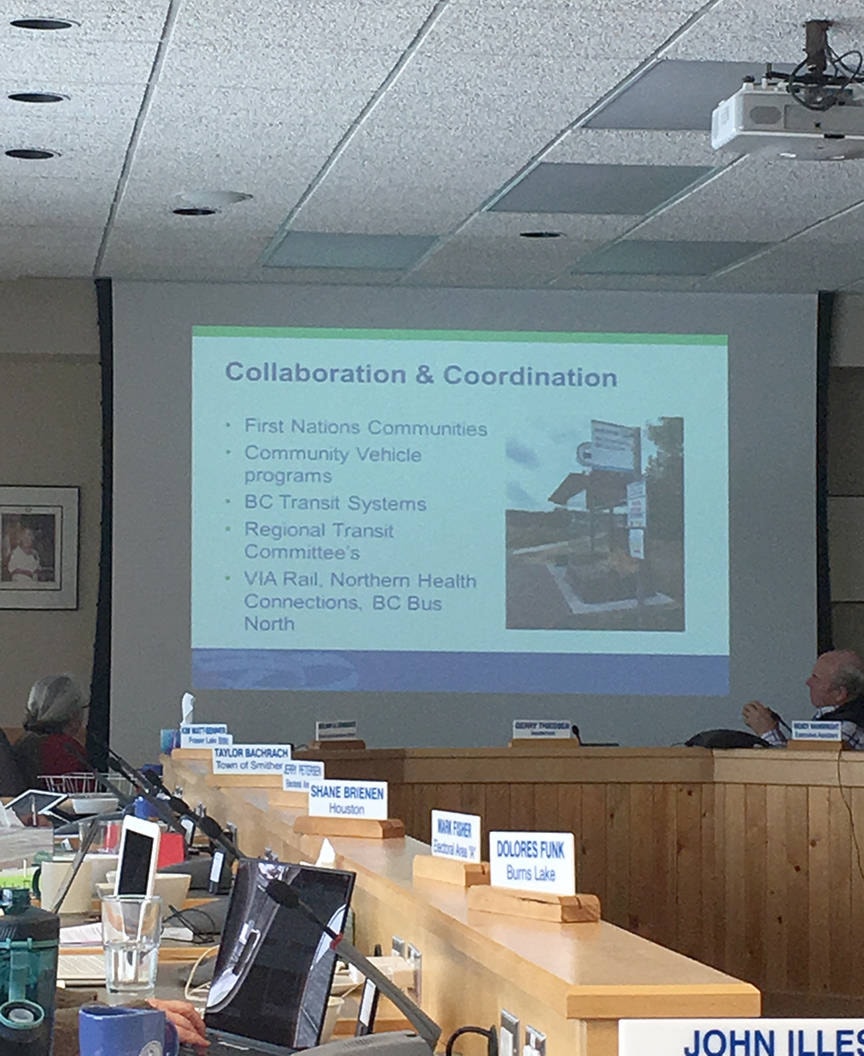Representatives from transportation authorities delivered a presentation on the Highway 16 Transportation Action Plan to the Regional District of Bulkley-Nechako’s board of directors on March 7, after the scheme launched in 2017.
Linda Harmon, Director of Strategic Outreach and Business Engagement with the Ministry of Transportation and Infrastructure, outlined that the plan was the result of a decade of public awareness campaigns about safety along the highway.
“In 2006 when there was the Highway of Tears symposium, in 2012 there was the missing women commission inquiry…It was in that 2012 report that public transportation along Highway 16 was made as an urgent recommendation. Then in 2014 there were consultations along the corridor. In 2015 there was the northern transportation symposium held. Out of that, the provincial government of the time developed the Highway 16 Transportation Action Plan. And in 2016 BC Transit started their engagement process.”
The five key elements of the plan include a $4.2 million contribution over five years from the provincial government for transit expansion, a community transportation grant program, First Nations driver education, webcams and transit shelters and increased connectivity.
The province pays all of the capital costs of the plan, and two thirds of the operating costs.
With the $2 million community transportation grant, “about $750,000 of that is for the purchase of vehicles for communities. The remainder is to help cover operating costs,” Harmon said.
Twelve communities received those grants, including Granisle, Saik’uz and several First Nations communities that have been connected to Highway 16.
The First Nations driver education program has received $400,000 to be used over three years, and is being delivered by Carrier Sekani Family Services, with the goal of raising the number of people with Class 4 and 5 licenses.
“Class 4 would allow people to drive a community bus or trucks. It creates opportunities for employment.”
So far 190 students have done the training, and almost 80 have received Class 4 or 5 licenses.
The webcam and transit shelter aspects have received $1 million from Indigenous and Northern Affairs Canada, and $500,000 from the provincial government, which went towards 12 webcams along Highways 15 and 16.
The fifth element of added connectivity has seen the start of BC Bus North which consists of routes between Prince George and Prince Rupert, Fort St. John, Dawson Creek and Fort Nelson and was intended to replace Greyhound when it stopped operating in northern British Columbia last year.
In that time 900 people have used the service and the Prince Rupert to Prince George route is the busiest, Harmon said.
The fare from Prince George to Prince Rupert is $45 one-way, and Harmon pointed out that to ride from Smithers to Prince George costs $35.
Robert Ringma, manager of government relations with BC Transit spoke after Harmon and presented details of the role of bus routes 161 (Prince George-Burns Lake) and 162 (Burns Lake-Smithers) in the action plan.
Those routes came in response to desire from local residents for an inter-community transit service connecting communities to regional centres, in contrast to the longer haul routes of BC Bus North.
The service started in June of 2017 and has had 15,000 passengers since then.
It operates on a cost-share basis with the local communities and the federal and provincial governments provide the vehicles.
Each bus has capacity for 30 people, with luggage racks and lifts for passengers in wheelchairs.
“The Highway 16 project has been recognized on a Canada scale. It’s been awarded the CUTA (Canadian Urban Transit Association) 2018 award for safety and security, and a premier’s award,” Ringma said.
He recounted an experience he had while riding on route 161 in Prince George, when he spoke with a First Nations woman who was on the bus with her young son.
“Her parents live in Burns Lake, she lives in Prince George and she basically said this is the only way she can get to Burns Lake to see her parents and for her son to see his grandparents. She was very happy with the $5 fare. And she went on to speak about how her mother used to hitchhike from Burns Lake to Prince George, and how unsafe she felt about that. This service fulfills a need for her and her family.”
Blair McBride
Multimedia reporter
Send Blair an email
Like Lakes District News on Facebook
